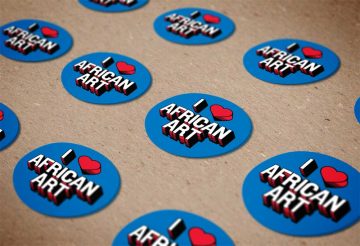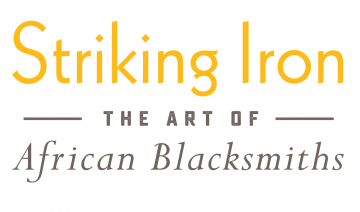 Thoughout the African continent, blades produced as weapons—spears, swords, axes, and knives—have served defensive purposes and achieved warlike ends. Blacksmiths have also transformed such weapons into insignia capable of performing political power.
Thoughout the African continent, blades produced as weapons—spears, swords, axes, and knives—have served defensive purposes and achieved warlike ends. Blacksmiths have also transformed such weapons into insignia capable of performing political power.
Blades have been deliberately removed from practical use by having their edges dulled; their aerodynamic balance decreased; their forms made larger, thinner, and more ornate than could serve ordinary purposes. These formidable and often magnificent forgings offered sensual pleasures of handling and also aestheticized power to communicate key ideas about honor, prosperity, prestige, and sophistication.
Note to visitors
Attributions for this exhibition have been compiled from collection data provided by lenders and scholarly sources. The historical testimony of travelers and scholars’ examination of the literature informs the attributions of the blades displayed in this section. Acquisition records can be vague or misleading, and very frequently similar types have been made, used, and traded among multiple peoples, sometimes over large areas.
Weapons of War
Efficient and elegant. Weapons produced by blacksmiths have enabled both technical and cultural revolutions among African peoples. Throwing and stabbing knives, spears, daggers, and shields may bear bitter histories, but they bespeak the heroism of the young men who wielded them. The efficacies of these weapons, often elegant in form and decoration, include their capacity to transmit potentialities—social, political, and spiritual.
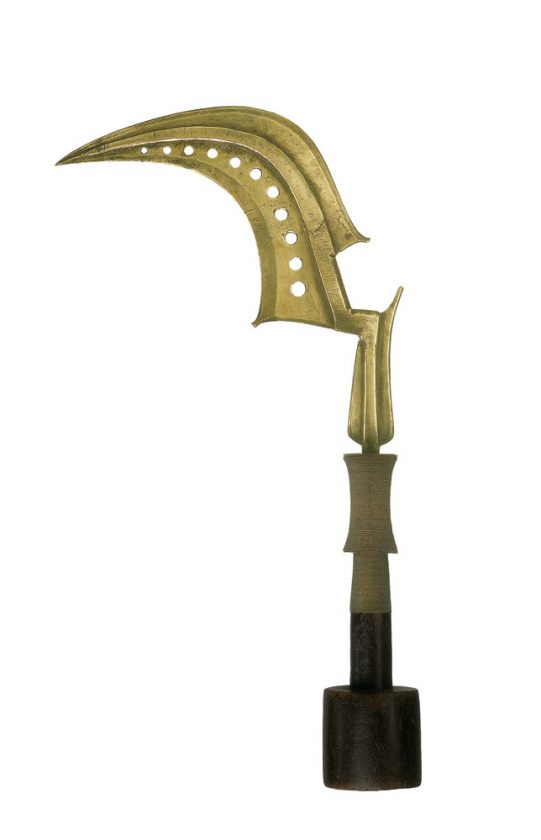
Democratic Republic of the Congo
Sickle knife (mambele, trumbash, nambele)
Late 19th to early 20th century
Copper alloy, wood
Felix Collection
Grasping power. This scepter belonged to a Mangbetu king. Its sickle-shaped blade (also suggestive of a throwing knife) shows how a lethal weapon could become an extension of a king’s grasp, communicating his power. The handles of such prestige objects were often enhanced with wrapped copper, pewter, or iron wire. Among Mangbetu, copper was deemed even more precious than iron, and the use of this softer metal underscored a blade’s symbolic rather than violent purpose.
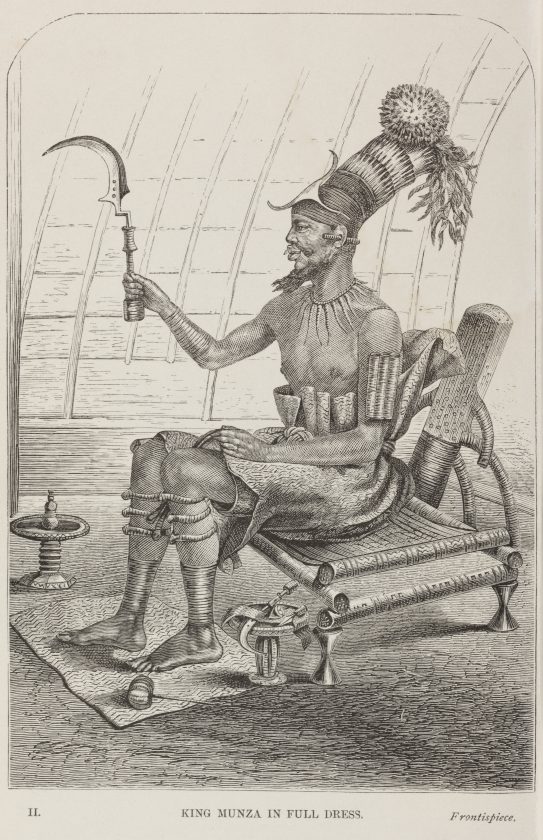
Engraving by J. D. Cooper. Reproduced in Georg Schweinfurth, Artes africanae: Abbildungen und beschreibungen von erzeugnissen des kunstfleisses centralafrikanischer völker (Leipzig: F. A. Brockhaus, 1874).
Blades of Eloquent Speech
Words of wisdom. Some axes and adzes have shafts of carved wood that end in delicately sculpted anthropomorphic heads or full figures from which forged blades—“tongues”—emerge. Particular ethnographic data on how they were used is scant, but we can imagine that these blades lent themselves to metaphor, as captured in the phrase “Wise words are a sharp tool.” Worn over the shoulder or held in the hand while dancing, such axes or adzes expressed the eloquent or “cutting edge” speech of those privileged to bear them.
Ekonda Ikakalaka | The Pride of Men
Incredibly improvised ironwork. Among the creations of Ekonda blacksmiths—revered as founders of lineages—are ikakalaka blades prized for their ornamentation and improvised forms. These “show knives” were not restricted to men. Rather, prominent women were also known to carry them and display them in public ceremonies honoring the birth of a first child.
Kuba Ikul | Forging Memory and Power
Talent and taste. The Bushong ruling elite of Kuba kingdoms considered smithing to be their forte, and a great variety of iron blades and related implements were forged by royal court members. One prominent Kuba knife, the ikul—worn by men in public as insignia—has a curved blade shaped like a broad leaf. Both its sides are blackened and selectively polished to highlight the midrib and one of its two beveled edges. Seemingly simple in design but stunning in technical precision, ikul demonstrate the talent of Kuba blacksmiths and the connoisseurship of elite Kuba men.
Forging Christianity in Africa | Ethiopia
Demonstrating devotion. Liturgical arts of locally forged iron have long been significant in the Coptic Orthodox Church of Abyssinia, founded in the fourth century CE or even earlier. Elaborate crosses are quintessential in expressing visual piety among Orthodox Christians throughout Ethiopia. Priests carry them in liturgical processions and use them to bless the faithful.
Forging Christianity in Africa | Kongo
In the 1490s, Portuguese adventurers reached the Kongo kingdom (present-day Angola and the Democratic Republic of the Congo). Christianity soon took root, strongly advocated by Kongo kings. Forged “swords of honor” were a synthesis of local associations of kingship with iron and European-derived associations of weapons with nobility and Christian knighthood. Iron swords were produced early on with hilts, as the examples here illustrate, and resonant with Christ’s body on the cross.
Islamic Calligraphic Blades of Mahdist Sudan
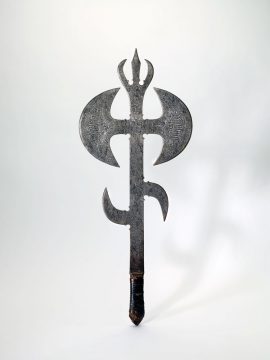
Sudan
Acid-etched scepter
19th century
Iron, leather, wood
Fowler Museum at UCLA, X65.3646, gift of the Wellcome Trust
Throwing Knives | Beauty that Strikes
Devastating and decorative. Throwing knives were made in profusion by master smiths across central and equatorial Africa. Scholars’ knowledge of them comes largely from reports of 19th-century Westerners visiting this vast region who reported seeing men with knives carried on their shoulders—almost as extensions of their bodies. Some were used as lethal instruments of war, carefully balanced aerodynamically to be hurled as missiles or swung sidearm with devastating accuracy. Other throwing knives were used as dance wands, insignia of leadership, bridewealth, or ritual accoutrements. Drawing prestige and power from combined precision and beauty, throwing knives are among the most remarkable innovations of African blacksmiths.
